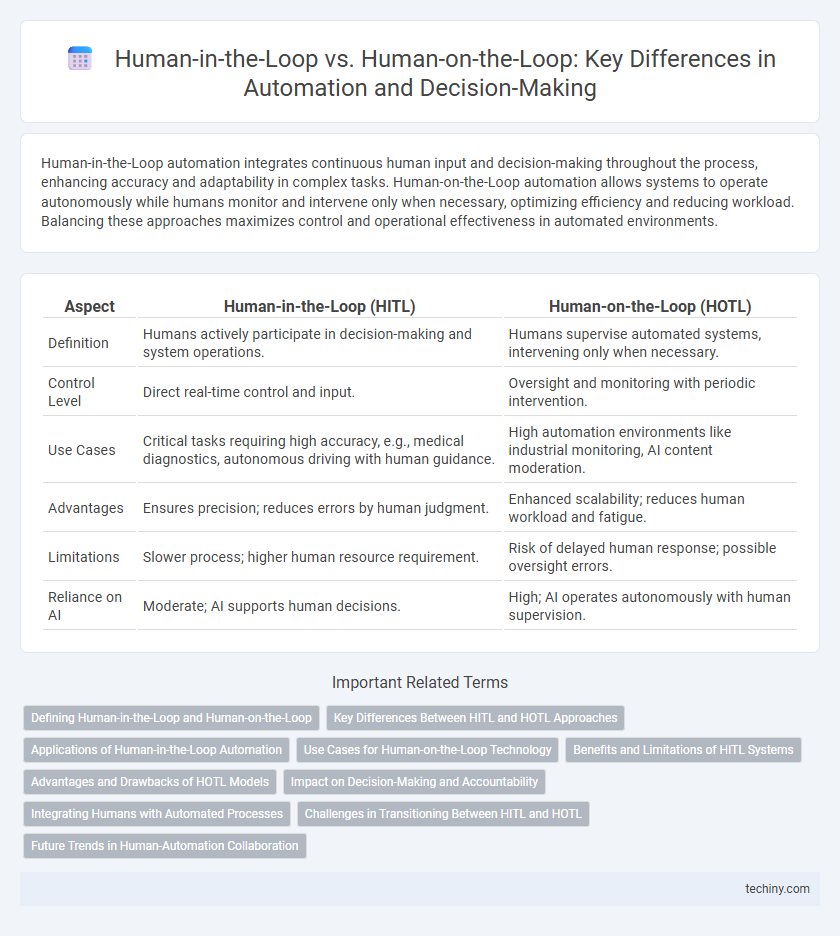Human-in-the-Loop automation integrates continuous human input and decision-making throughout the process, enhancing accuracy and adaptability in complex tasks. Human-on-the-Loop automation allows systems to operate autonomously while humans monitor and intervene only when necessary, optimizing efficiency and reducing workload. Balancing these approaches maximizes control and operational effectiveness in automated environments.
Table of Comparison
| Aspect | Human-in-the-Loop (HITL) | Human-on-the-Loop (HOTL) |
|---|---|---|
| Definition | Humans actively participate in decision-making and system operations. | Humans supervise automated systems, intervening only when necessary. |
| Control Level | Direct real-time control and input. | Oversight and monitoring with periodic intervention. |
| Use Cases | Critical tasks requiring high accuracy, e.g., medical diagnostics, autonomous driving with human guidance. | High automation environments like industrial monitoring, AI content moderation. |
| Advantages | Ensures precision; reduces errors by human judgment. | Enhanced scalability; reduces human workload and fatigue. |
| Limitations | Slower process; higher human resource requirement. | Risk of delayed human response; possible oversight errors. |
| Reliance on AI | Moderate; AI supports human decisions. | High; AI operates autonomously with human supervision. |
Defining Human-in-the-Loop and Human-on-the-Loop
Human-in-the-Loop (HITL) involves active human participation during an automated process, where humans review, intervene, or make decisions in real time to ensure accuracy and control. Human-on-the-Loop (HOTL) refers to a supervisory role, where humans monitor automated systems and intervene only when necessary, enabling faster decision-making with reduced human workload. Both approaches enhance automation by balancing machine efficiency with human judgment in fields like AI, robotics, and autonomous systems.
Key Differences Between HITL and HOTL Approaches
Human-in-the-Loop (HITL) requires continuous human intervention for decision-making and control within automation processes, ensuring accuracy and adaptability in complex scenarios. In contrast, Human-on-the-Loop (HOTL) involves human supervision with automated systems operating independently, allowing for oversight and intervention only when necessary. The key differences lie in the degree of human involvement, with HITL emphasizing active participation and HOTL focusing on monitoring and contingency management.
Applications of Human-in-the-Loop Automation
Human-in-the-loop automation integrates human judgment directly into decision-making processes, enhancing accuracy in complex applications such as autonomous vehicles, medical diagnostics, and fraud detection. This approach ensures continuous human oversight, allowing real-time intervention and correction in scenarios where full automation might fail due to unpredictable data or ethical concerns. Industries leveraging human-in-the-loop systems benefit from improved safety, compliance, and adaptability in dynamic environments.
Use Cases for Human-on-the-Loop Technology
Human-on-the-Loop technology excels in critical sectors such as autonomous vehicles, military defense systems, and industrial automation, where continuous human oversight ensures safety without direct intervention in real-time operations. This approach allows automated systems to perform complex tasks independently while humans monitor performance metrics, enabling swift decision-making in case of anomalies. Applications in air traffic control and smart manufacturing showcase how Human-on-the-Loop frameworks enhance operational efficiency and risk management by combining AI accuracy with human judgment.
Benefits and Limitations of HITL Systems
Human-in-the-Loop (HITL) systems enhance automation by integrating human judgment in critical decision-making, improving accuracy and adaptability in complex or unpredictable scenarios. The benefits include increased error detection, ethical oversight, and flexibility to handle exceptions, but limitations arise from slower processing speeds, potential human bias, and higher operational costs compared to fully autonomous systems. HITL remains essential in domains requiring nuanced interpretation and accountability, such as healthcare, defense, and autonomous vehicle management.
Advantages and Drawbacks of HOTL Models
Human-on-the-Loop (HOTL) models allow continuous human supervision with the system operating autonomously, providing a balance between automation efficiency and human oversight. Advantages include real-time intervention capabilities, improved safety, and reduced cognitive load compared to Human-in-the-Loop (HITL) models, enhancing operational scalability in complex environments. However, drawbacks involve potential overreliance on automation, slower response times in critical situations, and challenges in maintaining situational awareness when human attention is divided.
Impact on Decision-Making and Accountability
Human-in-the-Loop (HITL) integrates human judgment directly into the automation process, ensuring real-time decision-making accountability and reducing the risk of errors in complex scenarios. Human-on-the-Loop (HOTL) allows automated systems to operate independently while humans monitor and intervene only when necessary, enhancing efficiency but potentially diluting immediate accountability. Balancing HITL and HOTL models significantly influences organizational decision-making quality and responsibility allocation in automated workflows.
Integrating Humans with Automated Processes
Human-in-the-Loop (HITL) integrates human judgment directly within automated processes, enabling real-time decision making and error correction during operation. In contrast, Human-on-the-Loop (HOTL) positions humans as overseers who monitor automated systems and intervene only when anomalies or complex situations arise. Effective integration of humans in automation balances system efficiency with the adaptability of human insight, enhancing reliability and safety in critical processes.
Challenges in Transitioning Between HITL and HOTL
Transitioning between Human-in-the-Loop (HITL) and Human-on-the-Loop (HOTL) presents challenges such as maintaining situational awareness and ensuring seamless handoff of control to avoid decision-making delays. System designers must address variations in human cognitive workload and design interfaces that support rapid intervention when automated processes encounter anomalies. Balancing automation reliability with human oversight requires robust feedback mechanisms and adaptive control protocols to minimize operational risks during mode shifts.
Future Trends in Human-Automation Collaboration
Future trends in human-automation collaboration emphasize the increasing integration of Human-in-the-Loop (HITL) and Human-on-the-Loop (HOTL) systems to enhance flexibility and decision-making accuracy. Advancements in artificial intelligence and machine learning enable dynamic adjustment of human involvement levels, optimizing task allocation between automated systems and human operators. Industry sectors such as autonomous vehicles, healthcare, and manufacturing are pioneering adaptive interfaces that support seamless interaction and real-time oversight for improved safety and efficiency.
Human-in-the-Loop vs Human-on-the-Loop Infographic

 techiny.com
techiny.com